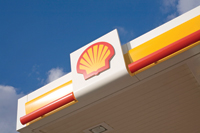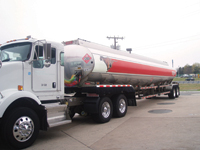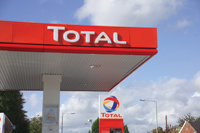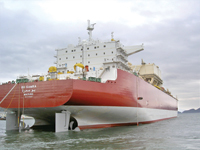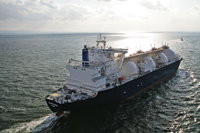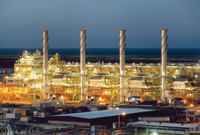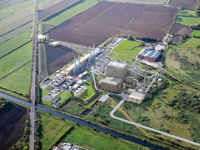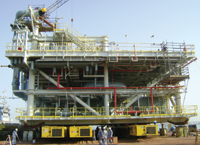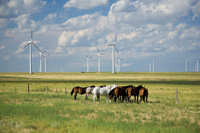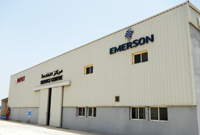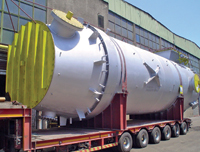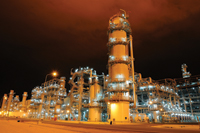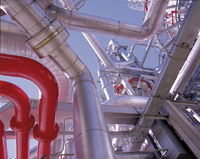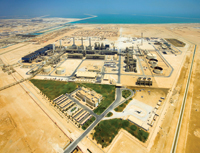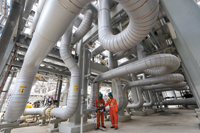
 Qatargas ... keeping Qatar on a firm footing
Qatargas ... keeping Qatar on a firm footing
QATAR, the world’s largest producer and exporter of liquefied natural gas (LNG), will see $185 billion worth of major projects until 2022 with significant investments in oil and gas, heavy industry, electricity generation and water desalination, social infrastructure and transportation links, says a report.
QNB Capital says that Qatar was the fastest growing global economy in 2011 with an estimated real GDP growth of 21 per cent and the oil and gas sector has been one of the main driving forces for GDP in 2011 with an expected growth of 29.5 per cent.
The key individual driver within this sector was natural gas, which witnessed a substantial growth in 2011 with LNG production capacity already reaching 77 million tonnes, from 62 million tonnes in 2010.
Condensate production (including gas-to-liquids (GTL)) reached 685,000 barrels per day (bpd) in 2011, from 396,500 bpd in 2010. Pipeline gas reached 4 billion cubic feet per day in 2011 through the Dolphin and Al Khalij projects. Also supporting growth for the economy is the crude oil sector with an average estimated production of 800,000 bpd in 2011 from 780,000 bpd in 2010. Although oil production capacity reached over 1 million barrels per day (mbpd) in 2011, output is restricted due to output targets set out by Opec.
The manufacturing sector got a major boost with extensive expansion in petrochemicals mainly through Q-Chem II, Qatofin, Ras Laffan ethylene cracker, and additional capacity at Qapco.
Qatar stands out in a region rich in oil, with the third largest natural gas reserves in the world, after Russia and Iran. This unique position puts it among the big international energy players, but also means costly investments.
In Qatar natural gas has its own town: Ras Laffan. In this port on the Strait of Hormuz 80 km north of the capital, natural gas is processed, refined, frozen or burned, and exported around the clock. People make their livings from it. Over the last 15 years, Qatar Petroleum (QP) and the big international energy companies (ExxonMobil, Shell, Total, Suez, etc) have invested $70 billion in building the world’s largest gas-processing facility on this deserted Gulf coast made up of sand and rocks. It has seven liquefaction factories, a refinery, a giant steamcracker (producing 1.3 million tonnes of ethylene a year), three power plants, several petrochemical units, and tanks 40 metres high and as wide as football pitches.
Fifty-four tankers, 20 per cent of the world’s fleet, service the port terminal.
The first cargo of petroleum products (gasoline, kerosene) derived from gas at the Pearl Plant set off in June 2011. The plant they came from was built by Shell, and employs up to 52,000 workers, housed in long rows of air-conditioned dormitories just 10 minutes from their workplace.
This gigantic effort is servicing the South Pars/North Dome Field, the world’s largest gas field, a geological rarity. Middle Eastern fields contain predominantly oil with a little natural gas, which for many years was burnt off in flares. This is the exact opposite. The field contains some oil (a high-quality oil called condensate, highly sought after by the chemical industry) and huge quantities of gas: 50,900 billion cubic metres, according to the International Energy Agency, the third-largest natural gas reserve in the world (14 per cent), after those in Russia and Iran. It lies under 65 metres of water and 3,000 metres of sand, right in the middle of the Gulf.
Qatar is currently producing 1.4 mbpd of crude oil and condensates, but only half of that is coming from crude. With little scope to pump more crude without risking damage to key reservoirs, Qatar is producing at “optimum output” from fields like Al Shaheen that were once hoped to provide the backbone of a massive expansion in production capacity, Qatari Energy Minister Mohammed Al Sada says.
 |
|
Al Sada ... letting Qatar produce flat out |
Al Sada says that Qatar is currently producing “flat out” at maximum capacity of 720,000-730,000 bpd of crude, raising suspicions with regard to Qatar’s total production capacity. Qatar’s production capacity was previously thought to be around 900,000 bpd, but as other Opec producers in the Mideast Gulf have increased output this year, Qatar’s own ability to do so has been called into question.
Not only did Qatar not meet its target to expand production capacity to 1.1 mbpd by 2010, but its output has actually slumped by nearly 200,000 bpd from a high of more than 900,000 bpd four years ago, according to production data from state Qatar Petroleum (QP). In 2011, Qatar produced an average of 735,000 bpd, the QP data shows.
It’s not clear whether the scaling back of Qatar’s production capacity was a deliberate tactic on the part of QP aimed at extending the life of the country’s oil reservoirs, or simply a reflection of accelerating decline rates at mature fields.
However, QP’s production data indicates that volumes from all of the country’s biggest producing fields have taken a major hit over the past few years.
The three fields operated by QP – Dukhan, Bul Hanine and Maydan Mahzam – produced a combined 296,000 bpd last year, down from 400,000 bpd in early 2008.
Dukhan, the country’s second-largest producing field and its only onshore development, saw output decline from 300,000 bpd to 221,000 bpd. It has been a similar story with most fields operated by foreign companies – output from Total’s Al Khaleej field has dropped by 33 per cent since 2008, while combined volumes from the three offshore fields operated by US Occidental are down by 17 per cent.
Qatar’s oil output strategy in recent years has been focused mainly on stabilising, rather than increasing, production from most fields. The planned capacity expansion largely hinged upon the offshore Al Shaheen field, which was expected to help boost Qatar’s production capacity from 900,000 bpd to around 1.1 mbpd. Denmark’s Maersk Oil and QP signed a development plan for Al Shaheen in 2005, which envisaged a production increase from 240,000 bpd to a plateau level of 525,000 bpd in 2010. Despite spending as much as $6.5 billion upgrading the field, Maersk only produced 294,000 bpd from the field last year, according to QP’s production data.
The technically challenging Al Shaheen field has been found in places to have a tighter reservoir than expected, and consequently lower reservoir pressure, making further output increases difficult, sources familiar with Maersk’s operations in Qatar say. Reflecting “the desire of QP,” Maersk says it is now focused on maintaining output for longer at a plateau rate of 300,000 bpd, rather than producing at a higher level for a shorter period.
“Output can go higher but reservoir engineers have advised that current production is the optimum output,” Al Sada says of Al Shaheen.
“It’s a technical issue how to sustain the capacity with proper reservoir management.”
In addition to dashing Qatar’s hopes of raising production capacity, the field’s flagging output also appears to have been the decisive factor in the scrapping of the planned 250,000 bpd Al Shaheen refinery in 2010. At the time, the decision was blamed on the impact of high costs on the project’s economics.
The project was scrapped in favour of expanding a condensate refinery at Ras Laffan to handle the large volumes of associated liquids that are expected to accompany the country’s massive hike in gas production by 2014.
“Practically, if we separate condensate from crude oil – they are the same – Qatar produces more than 1.4 million bpd of crude and condensate and this is the reality of what we inject into the market,” Al Sada says.
He says that by 2020, the government would invest $25 billion to expand local petrochemical industry.
Al Sada adds that the move came as the country planned to increase its annual petrochemical output capacity by more than a double from 9.2 million tonnes to 23 million tonnes over the next decade. On the other hand, he says that Qatar inked a contract with Royal Dutch Shell in December to develop a $6.4 billion petrochemicals complex in the Ras Laffan industrial city in the state.
 |
|
RasGas ... ramping up capacity |
It is worth noting that over the last ten years; Qatar has become the world’s biggest liquefied natural gas (LNG) exporter, however, it has imposed a moratorium on further export development of the country’s huge North Field, the source of its massive gas reserves, until 2014.
Meanwhile, the refining sector in Qatar is being expanded in a big way. Together with an oil refinery at Messai’eed running at 137,000 bpd, a second 146,000 bpd condensate splitter is being built at Ras Laffan in the north of the country which will be fed by Qatar’s two sets of LNG ventures – The QP-led Qatar Liquefied Gas Co (QatarGas) and Ras Laffan Liquefied Natural Gas Co (RasGas).
The state-owned Qatar Petroleum (QP) has put on hold an expensive 250,000 bpd oil refinery project to process heavy crude from the offshore giant Al Shaheen field.
Qatar Fuel (Wuqud), replacing National Oil Distribution Co (Nodco), was set up in 2002 from QP’s unbundled fuel storage and distribution assets, to be in charge of the sector. Wuqud, owned 40 per cent by QP and 60 per cent by public and private investors through the Qatar Exchange, in April 2002 got exclusive marketing and distribution rights for petroleum products in Qatar covering a 15-year period. Wuqud in 2010 reported net profits of QR1.17 billion, up 23 per cent from QR949 million in 2009.
Qatar is home to Shell’s flagship $18 billion Pearl project, which converts natural gas into clean-burning liquid transport fuels, and one of the company’s vast liquefied natural gas plants.
Qatar has thus become the world’s capital for gas-to-liquids (GTL), which produces ultra-clean fuels to be much in demand later in this decade. With Qatar having become the world’s biggest exporter of LNG, the emirate has plans to raise it LPG output and exports 120,000 bpd to 455,000 bpd by 2012-13. It will have the biggest fleets in the world to transport LNG and LPG.
Qatar Airways in early October 2009 made history by being the first airline to power a flight on a fuel made of natural gas out of a GTL plant from London’s Gatwick airport to Doha. The flight was the latest step in more than two years of scientific work carried out by a consortium consisting of Airbus, Qatar Airways, QP, Qatar Science and Technology Park, Rolls-Royce, Shell and WOQOD into the benefits of using GTL Jet Fuel to power commercial aircraft.
Shell developed and produced the 50-50 blend of synthetic GTL kerosene and conventional oil-based kerosine fuel. Qatar is set to become the world’s leading producer of GTL kerosene when it is put into commercial production from early 2012 at Pearl GTL in the Ras Laffan Industrial City.
Booming output of light condensate in the Middle East and Asia – with Qatar to produce 787,000 bpd of this by 2012-13 from 476,000 bpd in 2011 – offers refiners a cheap and fast way to make high profits, helping ease capacity strains after years of under-investment in the refining business on both sides of Suez. Condensate is a by-product of natural gas and its volumes are set to surge over the next few years as new blocks near the North Field gas super-giant will produce ultra-sour gas which will be sweetened locally to meet growing global demand for cleaner fuels.
The processing of condensate is necessary because it has a high content of sulphurous mercaptans. Importers have been reluctant to buy condensates from Qatar and Abu Dhabi, so both have opted for large condensate splitters.
Condensate can be blended with crude oil to run in refineries but can also be processed in splitters, an option growing more attractive as the best way to capitalise on rising demand for premium fuels. When processed through a splitter, condensate produces 50 per cent naphtha and a large portion of clean diesel, products whose profit margins will keep rising through this decade and the coming ones. The Middle East needs more capacity to make clean motor fuels, particularly lead-free gasoline and ultra-clean diesel. Major petrochemical makers in Asia require more naphtha as feedstock to produce ethylene, the basic building block for everything from compact discs to car dash-boards.
The attraction of a splitter is enhanced by bullish forecasts for condensate supply. Condensate output in the Middle East, Russian Far East and Asia/Pacific has been forecast to more than triple between 2003 and 2013 to almost 6 mbpd.
Growth is the production of condensate is out-stripping that for crude oil, reserves of which are dwindling in Asia. East of Suez condensate output will rise to over 14 per cent of total liquids production by 2013, up from 5.4 per cent in 1997.










































































